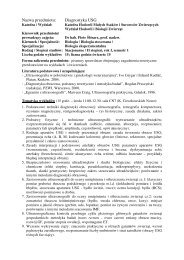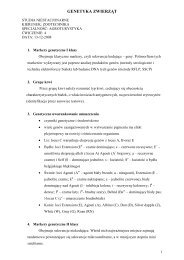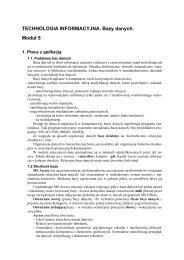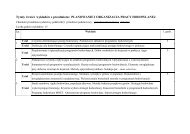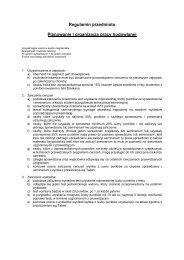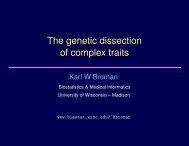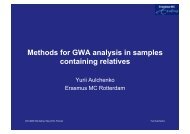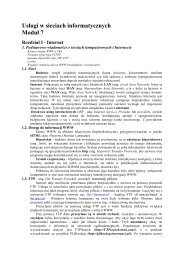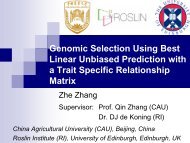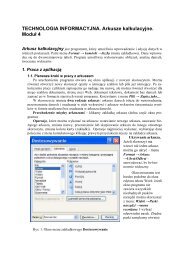The book of abstracts is available. - PoznaÅ
The book of abstracts is available. - PoznaÅ
The book of abstracts is available. - PoznaÅ
You also want an ePaper? Increase the reach of your titles
YUMPU automatically turns print PDFs into web optimized ePapers that Google loves.
14 th QTL-MAS Workshop, Poznań University <strong>of</strong> Life Sciences, Poland 2010Logic regression based methods in application to detection <strong>of</strong> gene-geneinteractionsMagdalena Malina 1* , Małgorzata Bogdan 21 Mathematical Institute, University <strong>of</strong> Wrocław2 Institute <strong>of</strong> Mathematics and Computer Science, Wrocław University <strong>of</strong> Technology,∗ Presenting author: Magdalena Malina, email: malina@math.uni.wroc.plBackground. We consider a biological problem <strong>of</strong> locating multiple interacting QTLs. Logicregression introduced in [2] by Ruczinski, Kooperberg, LeBlanc <strong>is</strong> a regression method,specifically aimed at detecting high order interactions in SNP data. <strong>The</strong> method attempts toconstruct predictors as Boolean combinations <strong>of</strong> dummy variables coding marker genotypes.<strong>The</strong> method searches for these combinations <strong>of</strong> predictors in the entire space <strong>of</strong> suchcombinations, which are represented by logic binary trees. In [1] Schwender and Ickstadtpropose a procedure called logicFS (logic feature selection) in which the “best” model <strong>of</strong> afixed dimension <strong>is</strong> estimated with simulated annealing, aimed at maximizing the likelihood.<strong>The</strong> instability <strong>of</strong> binary trees <strong>is</strong> overcome by using bootstrap aggregation. Based on bootstrapreplications, for each interaction an importance measure <strong>is</strong> calculated. <strong>The</strong> method can beapplied for both binary and quantitative responses.Results. We applied LogicFS for QTL mapping. We analyzed two real QTL data sets (see[3], [4]). <strong>The</strong> data by Lyons et.al ([3]) contains different phenotypes related to cholesterolgallstone formation detected in an intercross <strong>of</strong> CAST/Ei and 129S1/SvImJ inbred mice. Wesearched for interactions that influence gallbladder bile character<strong>is</strong>tics (binary variable). <strong>The</strong>second data set ([4]) considers different phenotypes related to obesity detected in an intercross<strong>of</strong> SM/J and NZB/BINJ inbred mice. Here we searched for interactions that influence gonadalfat pads weight. For both data sets logicFS was able to detect several interactions which werenot reported in original papers.Conclusions. Logic regression models allow to present very complex linear models withmany parameters in a much simpler form. Increasing number <strong>of</strong> components that may beincluded to models <strong>of</strong> th<strong>is</strong> form causes also that the problem <strong>of</strong> multiple testing become morecomplex. In such models however it <strong>is</strong> easier to get to the higher order interactions withoutaddition <strong>of</strong> new parameters. Interactions included in such model are also much easier tointerpret. According to our results, logicFS can be successfully applied to identification <strong>of</strong>interacting QTLs.[1]Schwender, H. and Ickstadt, K. (2008). Biostat<strong>is</strong>tics, 9. 187-198[2] Ruczinski I., Kooperberg C., LeBlanc M. (2003). J. Comput. Graphical Stat<strong>is</strong>t. 12 (3) 474-511[3] Lyons MA, Wittenburg H, Li R, Walsh KA, Leonard MR, Churchill GA, Carey MC, Paigen B. Physiol Genomics. 2003Aug 15;14(3):225-39. PMID 12837957[4] Stylianou IM, Korstanje R, Li R, Sheehan S, Paigen B, Churchill GA. Mamm Genome. 2006 Jan;17(1):22-36. PMID1641608839



